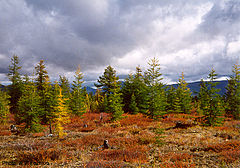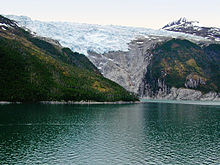LIMSpec Wiki
Contents

The tree-line or timberline is the edge of the habitat at which trees can grow. Beyond the tree-line, they are unable to grow as conditions are too bad.
There are several types of tree lines defined in ecology and geology:
- Arctic tree-line The farthest north in the Northern Hemisphere that trees can grow; farther north, it is too cold.
- Antarctic tree-line The farthest south in the Southern Hemisphere that trees can grow; farther south, it is too cold as well.
- Alpine tree-line The highest height where trees grow: higher up, it is too cold, or snow covers the ground for too much of the year. The climate above the tree-line is called an alpine climate.
- Exposure tree-line On coasts and isolated mountains, the tree-line is often much lower than in corresponding altitudes inland and in larger, more complex mountain systems, because of strong winds reduce tree growth.
- Desert tree-line The places where trees cannot grow as there is too little rainfall.
- Toxic tree-line The environment is too extreme for trees to grow. This can be caused by molten lava or hot rock (infrared radiation), any of several kinds of fumarole (steam, sulfur, acid), soil pH, low oxygen conditions, salt concentrations (as near the Dead Sea or Great Salt Lake), sulfate levels, other natural causes, or by man made pollution.
- Wetland tree-line The wettest ground on the margins of muskegs and bogs that trees can grow in, below which the ground is too saturated with water, excluding oxygen from the soil that tree roots need to grow. However, no such line exists for swamps, where trees, such as Bald cypress and the many mangrove species, are adapted to growing in permanently waterlogged soil.

At the tree line, tree growth is often not clear with the last trees forming low bushes. If it is caused by wind, these are known as krummholz, from the German for 'twisted wood'.
The tree line, like many other natural lines (lake boundaries, for example), appears well-defined from a distance, but upon close inspection, it is not that clear. Trees grow shorter until they simply stop growing.
Typical tree-line species

Some typical tree-line tree species (note the predominance of conifers):
- Dahurian Larch (Larix gmelinii)
- Foxtail Pine (Pinus balfouriana)
- Great Basin Bristlecone Pine (Pinus longaeva)
- Rocky Mountains Bristlecone Pine (Pinus aristata)
- Potosi Pinyon (Pinus culminicola)
- Macedonian Pine (Pinus peuce)
- Whitebark Pine (Pinus albicaulis)
- Swiss Pine (Pinus cembra)
- Mountain Pine (Pinus mugo)
- Hartweg's Pine (Pinus hartwegii)
- Subalpine Larch (Larix lyallii)
- Arctic White Birch (Betula pubescens subsp. tortuosa)
- Snow Gum (Eucalyptus pauciflora)
- Antarctic Beech (Nothofagus Antarctica)
Alpine tree-lines
The alpine tree-line at a location is dependent on local variables, such as aspect of slope, rain shadow and proximity to either geographical pole. Given this caveat, here is a list of average tree-lines from locations around the globe:
| Location | Approx. latitude | Approx. elevation of tree-line | Notes | |
|---|---|---|---|---|
| (m) | (ft) | |||
| Sweden | 68°N | 800 | 2600 | |
| Norway | 61°N | 1100 | 3600 | Lower near the coast |
| Swiss Alps | 46°N | 2100 | 6900 | Higher in the southern side of the Alps. |
| New Hampshire, USA | 44°N | 1220 | 4000 | Some peaks with lower treelines due to fire and subsequent loss of soil. |
| Wyoming, USA | 43°N | 3000 | 9800 | |
| Rocky Mountain NP, USA | 40°N | 3500 | 11500 | On warm SW slopes; lower (about 2400 m or 8000 ft) on NE slopes |
| Japanese Alps | 39°N | 2900 | 9500 | |
| Yosemite, USA | 38°N | 3200 | 10500 | West side of Sierra Nevada |
| Yosemite, USA | 38°N | 3600 | 11800 | East side of Sierra Nevada |
| Himalaya | 28°N | 4400 | 14400 | |
| Hawaii, USA | 20°N | 2800 | 9000 | Precipitation low above the trade winds |
| Costa Rica | 9.5°N | 3400 | 11200 | |
| Mount Kilimanjaro, Tanzania | 3°S | 3000 | 9800 | |
| New Guinea | 6°S | 3900 | 12800 | |
| Andes, Peru | 11°S | 3900 | 12800 | East side; on west side tree growth is restricted by dryness |
| Sierra de Córdoba, Argentina | 31°S | 2000 | 6560 | Precipitation low above trade winds, also high exposure |
| Australian Alps, Australia | 36°S | 2000 | 6560 | West side of Australian Alps |
| Australian Alps, Australia | 36°S | 1700 | 5580 | East side of Australian Alps |
| South Island, New Zealand | 43°S | 1200 | 3940 | Strong maritime influence serves to cool summer and restrict tree growth |
Arctic and Antarctic tree-lines
Like the alpine tree-lines shown above, polar tree-lines are heavily influenced by local variables such as aspect of slope and degree of shelter; trees can often grow in river valleys at latitudes where they could not grow on a more exposed site. Maritime influences such as ocean currents also play a major role in determining how far from the equator trees can grow. Here are some typical polar treelines:
| Location | Approx. longitude | Approx. latitude of tree-line | Notes |
|---|---|---|---|
| Norway | 24°Q | 71°N | The North Atlantic current makes Arctic climates in this region warmer than other coastal locations at comparable latitude. |
| West Siberian Plain | 75°R | 66°N | |
| Central Siberian Plateau | 102°S | 72°N | Extreme continental climate means the summer is warm enough to allow tree growth at higher latitudes, extending to 72°30'N at Ary-Mas (102° 27' E) in the Novaya River valley, a tributary of the Khatanga River. |
| Russian Far East (Kamchatka and Chukotka) | 160°E | 60°N | The Oyashio Current and strong winds affect summer temperatures to prevent tree growth. The Aleutian Islands are almost completely treeless. |
| Alaska | 152°W | 68°N | Trees grow north to the south facing slopes of the Brooks Range. The mountains block cold air coming off of the Arctic Ocean. |
| Northwest Territories, Canada | 132°W | 69°N | Reaches north of the Arctic Circle due to the continental nature of the climate and warmer summer temperatures. |
| Nunavut | 95°W | 61°N | Influence of the very cold Hudson Bay moves treeline southwards. |
| Quebec | 72°W | 56°N | Very strong influence of the Labrador Current on summer temperatures. In parts of Labrador, the treeline extends as far south as 53°N. |
| Greenland | 50°W | 64°N | Determined by experimental tree planting in the absence of native trees due to isolation from natural seed sources; a very few trees are surviving, but growing slowly, at Søndre Strømfjord, 67°N. |
| Tierra del Fuego, Chile and Argentina | 69°W | 55°S | Tree growth reaches very close to the southernmost point of South America, with the limit related to extreme exposure rather than climate. |

References
- Arno, S. F. & Hammerly, R. P. 1984. Timberline. Mountain and Arctic Forest Frontiers. The Mountaineers, Seattle. ISBN 0-89886-085-7
- Ødum, S. 1979. Actual and potential tree-line in the North Atlantic region, especially in Greenland and the Faroes. Holarctic Ecology 2: 222-227.
- Ødum, S. 1991. Choice of species and origins for arboriculture in Greenland and the Faroe Islands. Dansk Dendrologisk Årsskrift 9: 3-78.
- Beringer, J., Tapper, N. J., McHugh, I., Lynch, A. H., Serreze, M. C., & Slater, A. 2001. Impact of Arctic treeline on synoptic climate. Geophysical Research Letters 28 (22): 4247-4250.

















